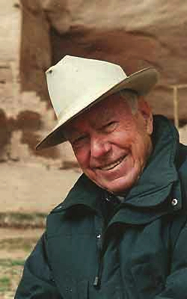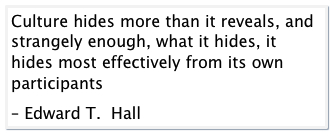A recent book from Martha Bayles, a lecturer in humanities at Boston College, tackles the question of how American entertainment industry products confound official U.S. government efforts to represent the nation to...
KEEP READINGThe CPD Blog is intended to stimulate dialog among scholars and practitioners from around the world in the public diplomacy sphere. The opinions represented here are the authors' own and do not necessarily reflect CPD's views. For blogger guidelines, click here.
Culture Posts: Developing Cultural In-Awareness in Public Diplomacy
One of the goals of this blog series is to develop greater awareness and knowledge of how culture intervenes in public diplomacy. In public diplomacy, culture’s web of influence spans across policy, practice, and research, and encompasses both sponsor and intended public.
The problem is that much of culture’s influence lays “out-of-awareness” for both the sponsor and the intended public in public diplomacy. As further irony, the sponsor and the public may have some awareness of the other’s cultural features, but are often unable to see culture’s influence on themselves. These hidden aspects tend to be the source of cultural misunderstandings and tensions.
One of the keys to effective public diplomacy is developing an “in-awareness” cultural approach to public diplomacy.
Origins of Intercultural Communication in Traditional Diplomacy
The idea of “in-awareness” comes from American anthropologist, Edward T. Hall. Some may recognize Hall as one of the founders of the field of intercultural communication. However, Hall’s work began not in communication, but in diplomacy at the Foreign Service Institute (FSI) of the U.S. State Department.

Following World War II, the State Department found that the effectiveness of its diplomats was hampered by lack of language and cultural knowledge. In 1949, the U.S. FSI was established to better train diplomats. Hall was one of several anthropologists and linguists who joined the FSI.
Originally, Hall and the other anthropologists lectured on the broad, macro-level aspects of culture such as politics, economy, or religion. The diplomats, however, were concerned about what happens when two people from different cultures interact.
Hall shifted his focus to applied culture. He developed experiential techniques such as role-playing and situational exercises for the diplomats.
After writing a few popular pieces, Hall published The Silent Language (1959). The book was the first in a series that shared his ideas about culture and communication. His book enjoyed wide popularity selling over 500,000 copies in the early 1960s.

The Silent Language
In The Silent Language, Hall showed how we can communicate volumes without saying a word. The problem is that most of what and how we communicate escapes our awareness, or is “out-of-awareness.”
Not only do we learn most of our behaviors “out-of-awareness,” but we tend to perform them “out-of-awareness” as well.
One of the great “out-of-awareness” examples is the subtle “dance” between two diplomats conversing at a reception.
Bringing communication and culture “in-awareness” does not only apply to how one views others from different cultures. Gaining self-awareness about culture’s influence on one’s own behavior can often be as insightful and constructive as learning about others.
Without a conscious awareness of how another culture differs from one's own, there is a tendency to see the differences of another through the prism of one's culture. Ethnocentricity occurs when one uses their own cultural standards as a yardstick for measuring other cultures; inevitably the other culture comes up lacking.

Often, awareness and knowledge go hand-in-hand. Greater cultural awareness is key to building and refining one’s trove of cultural knowledge. And, with greater knowledge comes an awareness of the nuances that expose cultural variations.
Awareness is also critical when one considers the dynamic nature of culture. Culture is a human-created and human-perpetuated organic phenomenon. In future “Culture Posts”, I hope to talk about the provocative idea of “culture as a verb.”
Public Diplomacy Cultural In-Awareness
Hall’s work on cultural in-awareness for traditional diplomacy helps provide inspiration for the work that lies ahead for public diplomacy. Traditional diplomacy may often enjoy the luxury of private settings. Public diplomacy often does not.
Hall focused primarily on nonverbal behaviors and communication between individuals. In public diplomacy, practitioners are challenged to consider how their actions and communication may be perceived. Their actions may be magnified under public scrutiny and then amplified by media exposure.
The example of the dance of misunderstanding between two diplomats involved behavioral differences in perceptions of space. The list of potential cultural variations between a public diplomat and the publics she seeks to communication is long.
As we begin this trek of cultural in-awareness, we may begin by looking our environment and actions anew, and asking: What areas and aspects might we be taking for granted or holding out-of-awareness in how we practice and assess public diplomacy? What can we shine a spotlight on and bring it in-awareness for public diplomacy?
Visit CPD's Online Library
Explore CPD's vast online database featuring the latest books, articles, speeches and information on international organizations dedicated to public diplomacy.
POPULAR ARTICLES
-
November 13
-
November 25
-
January 2
-
December 17
-
December 15
Join the Conversation
Interested in contributing to the CPD Blog? We welcome your posts. Read our guidelines and find out how you can submit blogs and photo essays >.













